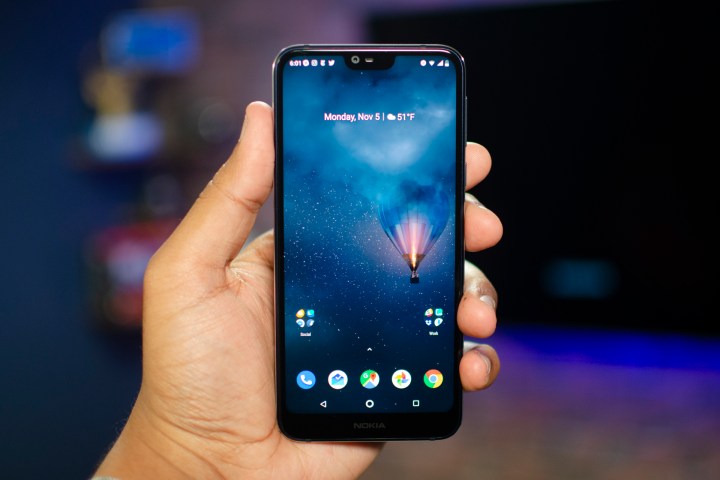
The Motorola One Vision looks like a serious bargain. It boasts a large display, a dual-lens 48-megapixel and 5-megapixel camera, and plenty of stamina. With Android One, it’s also certain to be updated in a timely fashion. But is it the best Android phone in this price range? We are big fans of the Nokia 7.1, so we decided to pit the two against one another in a series of categories to find an overall winner.
Specs
| Motorola One Vision | Nokia 7.1 | |
| Size | 160.1 × 71.2 × 8.7 mm (6.3 × 2.8 × 0.34 inches) | 149.7 × 71.1 × 8mm (5.89 × 2.79 × 0.31 inches) |
| Weight | 180 grams (6.35 ounces) | 160 grams (5.64 ounces) |
| Screen Size | 6.3-inch IPS LCD | 5.8-inch PureDisplay IPS LCD |
| Screen resolution | 2,520 × 1,080 pixels (432 pixels per inch) | 2,280 × 1,080 pixels (435 pixels-per-inch) |
| Operating system | Android 9.0 Pie | Android 9.0 Pie |
| Storage space | 128GB | 64GB |
| MicroSD card slot | Yes | Yes |
| Tap-to-pay services (NFC) | Google Pay | Google Pay |
| Processor | Samsung Exynos 9610 | Qualcomm Snapdragon 636 |
| RAM | 4GB | 4GB |
| Camera | Dual lens 48-megapixel and 5MP rear, 25MP front | Dual 12-megapixel and 5MP rear, 8MP front |
| Video | 2,160p at 30 fps, 1,080p at 60 fps | 2,160p at 30 fps, 1,080p at 30 fps |
| Bluetooth version | Bluetooth 5.0 | Bluetooth 5.0 |
| Ports | USB-C, 3.5mm headphone jack | USB-C, 3.5mm headphone jack |
| Fingerprint sensor | Yes (back) | Yes (back) |
| Water resistance | IP52 | No |
| Battery | 3,500mAh
Fast charging 15W |
3,060mAh
Fast charging 18W |
| App marketplace | Google Play Store | Google Play Store |
| Network support | TBA | T-Mobile, AT&T |
| Colors | Bronze, Sapphire | Midnight Blue, Gloss Steel |
| Price | 299 euros (around $335) | $350 |
| Buy from | Motorola | Amazon |
| Review score | News | 4 out of 5 stars |
Performance, battery life, and charging

While Motorola has packed a Samsung Exynos 9610 processor into the One Vision, Nokia has gone with a Snapdragon 636 in the 7.1. Both are midrange chips that offer similar performance levels, but the Samsung processor may have a slight edge in terms of graphics and image processing. Both devices have 4GB of RAM. The One Vision also offers 128GB of storage, while the Nokia 7.1 makes do with 64GB, but both have MicroSD card slots for expansion.
The Motorola One Vision dominates in the battery department, too, with an extra 440mAh of capacity over the 3,060mAh battery in the
Winner: Motorola One Vision
Design and durability
The Motorola One Vision is a much bigger and heavier phone than the
The Motorola One Vision scores an IP52 rating, but the
Winner: Motorola One Vision
Display

Both these phones have LCD screens. The 6.3-inch display in the Motorola One Vision boasts a 2,520 x 1,080-pixel resolution that works out to 432 pixels per inch (ppi), while the
Winner: Tie
Camera

The Motorola One Vision boasts an impressive dual-lens main camera that pairs a 48-megapixel lens with a 5-megapixel lens. It turns out 12-megapixel photos, but a technique called pixel binning boosts the quality. The
On the selfie front, the One Vision boasts a 25-megapixel camera while the
Winner: Motorola One Vision
Software and updates

We’re pleased to report that both these phones are Android One devices. It offers the best experience for budget phones and we’ve preferred Nokia devices to Motorola ones in the past for this reason. The Android One program means no bloatware, just pure
Since both phones currently run
Winner: Tie
Special features

We’ve talked about the various A.I. and image processing smarts in the One Vision camera, the Moto gestures, and
Winner: Motorola One Vision
Price and availability
We don’t yet know whether the Motorola One Vision will be released in the U.S., but it is available in Europe for 299 euros (around $335). You can also buy it in the U.K. from the end of May for 269 British pounds.
The
Overall winner: Motorola One Vision
As the newer phone, it’s not surprising that the Motorola One Vision carries the day. It’s a little faster, has a bit more stamina, a slightly better design, and offers a bit more in the camera department. At the same price, or even slightly less, than the




